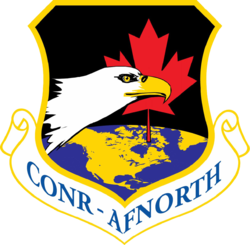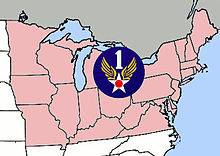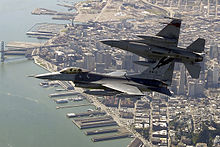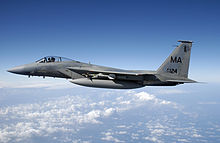- First Air Force
-
First Air Force (Air Forces Northern) 
First Air Force emblem

CONR-AFNORTH EmblemActive 18 December 1940 Country United States of America Branch United States Air Force Size 2,300 Part of Air Combat Command
United States Northern CommandGarrison/HQ Tyndall Air Force Base Commanders Current
commanderMaj. Gen. Garry C. Dean The First Air Force (Air Forces Northern) (1 AF-AFNORTH) is a numbered air force of the United States Air Force Air Combat Command (ACC). It is headquartered at Tyndall Air Force Base, Florida.
Its primary mission is the air defense of the Contiguous United States (CONUS), United States Virgin Islands and Puerto Rico. Its mission lineage can be traced to the Air Defense Command, one of the original USAAF major commands formed in 1946.
One of the four original pre-World War II numbered air forces, 1 AF was activated on 18 December 1940, at Mitchel Field, Long Island, New York with a mission of air defense of the Northeastern United States and Great Lakes regions. During the war, its primary mission became the organization and training of combat units prior to their deployment to the overseas combat air forces.
1 AF is commanded by Major General Garry C. Dean. Its Command Chief Master Sergeant is Chief Master Sgt. Joseph E. Thornell Sr..
Contents
Overview
The command has sole responsibility for ensuring the air sovereignty and air defense of the Contiguous United States (CONUS), United States Virgin Islands and Puerto Rico. As the CONUS Region (CONR) for NORAD, the bi-national North American Aerospace Defense Command, CONR provides air defense in the form of airspace surveillance and airspace control.
1AF (AFNORTH) is also the designated air component for the United States Northern Command (USNORTHCOM). USNORTHCOM's area of responsibility includes the continental United States, Alaska, Canada and Mexico, and its air, land and maritime approaches.
The command is unique in both its mission and composition. With the transfer of responsibility for continental air defense from the active duty component of the Air Force to the Air National Guard, 1 AF became the first numbered air force to be made up primarily of citizen airmen.
Units
First Air Force has been an Air Combat Command organization since 1 June 1992. Its subordinate units are located throughout the continental United States.
Units aligned under First Air Force/AFNORTH include:
- Eastern Air Defense Sector (EADS), Rome, New York
- Western Air Defense Sector (WADS), McChord AFB Washington
- 601st Air and Space Operations Center (601 ASOC), Tyndall AFB, Florida
- Air Force Rescue Coordination Center (AFRCC), Tyndall AFB, Florida
- Air Force National Security Emergency Preparedness Agency (AFNSEP), Tyndall AFB, Florida
- 1 AF Detachment 1, Winnipeg, Manitoba, Canada
- 702nd Computer Support Squadron (702 CSS), Tyndall AFB, Florida
- AFELM JADOC, Bolling AFB, District of Columbia.
- 722nd Air Defense Squadron (722 ADS), North Bay, Ontario, Canada
Additionally, First Air Force provides operational control of alert Air National Guard air defense fighter units:
- 119th Wing (119 WG), Fargo Airport, North Dakota, MQ-1 Predator, C-21A
- Detachment 1, 119 FW, Langley AFB, Virginia
- 120th Fighter Wing (120 FW), Great Falls IAP, Montana, F-16 Fighting Falcon
- 125th Fighter Wing (125 FW), Jacksonville IAP, Florida, F-15 Eagle
- Detachment 1, 125 FW, Homestead ARS, Florida
- 142d Fighter Wing (142 FW), Portland IAP, Oregon, F-15 Eagle
- 144th Fighter Wing (144 FW), Fresno AP California, F-16 Fighting Falcon
- Detachment 1, 144 FW, March ARB, California
- 147th Reconnaissance Wing (147 RW), Ellington ANG Base, Texas, MQ-1 Predator, C-26 Metroliner
- 148th Fighter Wing (148 FW), Duluth IAP, Minnesota, F-16 Fighting Falcon
- 158th Fighter Wing (158 FW), Burlington AP, Vermont, F-16 Fighting Falcon
- 177th Fighter Wing (177 FW), Atlantic City AP, New Jersey, F-16 Fighting Falcon
Non-flying units
- 101st Information Operations Flight (101 IOF), Salt Lake City IAP, Utah
- 254th Combat Communications Group (254 CCG), Garland, Texas
History
One of the four original numbered air forces, First Air Force was activated as the Northeast Air District of the GHQ Air Force on 18 December 1940, at Mitchel Field, Long Island, New York. It was redesignated First Air Force on 9 April 1941 with a mission for the defense of the Northeast and Great Lakes regions of the United States.
World War II
During the initial months after the Pearl Harbor Attack, First Air Force organized what would eventually become the Army Air Forces Antisubmarine Command (AAFSC), obtaining most of its forces from I Bomber Command to combat the German U-Boat threat along the Atlantic Coast. AAFSC would eventually expand that mission to the Gulf of Mexico and Caribbean until the Antisubmarine mission was taken over by the Navy in mid-1943.
Beginning in 1942, the mission of First Air Force became supporting the Army Air Forces Training Command's mission of training of units, crews, and individuals for bombardment, fighter, and reconnaissance operations. After personnel graduated from AAFTC flight schools; navigator training; flexible gunnery schools and various technical schools, First Air Force organized the personnel, aircraft and equipment into combat groups and squadrons. The newly-formed units received secondary training prior to their assignment to the deployed combat air forces in the various overseas theaters. Most P-47 Thunderbolt fighter groups were trained by I Fighter Command, along with P-39/P-63 Airacobra groups; C-47 Skytrain and later C-46 Commando groups by I Troop Carrier Command. In addition, the command performed training through Army Air Forces Training Command of units, crews, and individuals for specialized bombardment, and reconnaissance operations. By 1944, most of the Operational Training of groups ended, with the command concentrating on the training of replacement personnel, using Army Air Force Base Units (AAFBU) as training organizations at the airfields controlled by First Air Force.
Air Defense Wings were also organized for the major metropolitan areas along the northeast coast, using training units attached to the Wings. By 1944 the likelihood of an air attack along the eastern seaboard was remote, and these air defense wings were reduced to paper units.
By 1944, the vast majority of the USAAF was engaged in combat operations in various parts of the world, such as the Eighth Air Force in Europe and the Twentieth Air Force in the Pacific. The training units located within the United States (known as the Zone of the Interior, or "ZI".) under First, Second, Third and Fourth Air Force were all were placed under the unified command of the Continental Air Forces (CAF) on 13 December 1944, with the Numbered Air Forces becoming subordinate commands of CAF.
Air Defense Command
In March 1946, USAAF Chief General Carl Spaatz had undertaken a major re-organization of the postwar USAAF that had included the establishment of Major Commands (MAJCOM), who would report directly to HQ United States Army Air Forces. Continental Air Forces was inactivated, and First Air Force was assigned to the postwar Air Defense Command in March 1946 and subsequently to Continental Air Command (ConAC) in December 1948 being primarily concerned with air defense.
The command was originally assigned the region of the New England states, along with New York and New Jersey. With the inactivation of the ADC Eleventh Air Force on 1 July 1948 due to budget restrictions, command's region of responsibility was increased to include the upper Midwest states of Michigan and Ohio, along with the Mid-Atlantic region south to the North Carolina/Virginia Border.
In 1949 Air National Guard and Air Force Reserve units were placed under First Air Force command, with its active-duty units being reassigned to Eastern Air Defense Force (EADF) or to the 30th, 32d or 26th Air Divisions.
The command was inactivated on 23 June 1958 for budgetary reasons, its assigned units being reorganized under ConAC.
First Air Force was reactivated at Stewart Air Force Base, Newburgh, N.Y., on 20 January 1966 due to the inactivation of the ADC Air Defense Sectors. First Air Force assumed responsibility for the ADC 21st, 33d, 34th, 35th, and 36th Air Divisions, primarily located in the northeast and upper Midwest regions of the United States. It also was responsible for the air defense of Greenland, Iceland and parts of Canada. By July 1968, First Air Force had again assumed total responsibility for the air defense of the eastern seaboard, just as it had during World War II.
On 16 January 1968 Air Defense Command was re-designated Aerospace Defense Command (ADCOM) as part of a restructuring of USAF air defense forces. First Air Force's second period of service was short lived, however, and the command was again inactivated as the result of a major ADCOM reorganization on 31 December 1969 of the First, Fourth, Tenth Air Forces and several Air Divisions. This reorganization was the result of the need to eliminate intermediate levels of command in ADCOM driven by budget reductions and a perceived lessening of the need for continental air defense against attacking Soviet aircraft.
ADCOM reassigned the units under the inactivated First Air Force were reassigned primarily to the 20th, 21st or 23d Air Divisions.
Tactical Air Command
As part of realignment of military assets. ADCOM was reorganized on 1 October 1979. The atmospheric defense resources (interceptors and warning radars) of ADCOM were reassigned to Tactical Air Command (TAC). With this move many Air National Guard units that had an air defense mission also came under the control of TAC, which established a component called Air Defense, Tactical Air Command (ADTAC), at the level of an Air Division.
On 6 December 1985 HQ USAF reactivated First Air Force at Langley Air Force Base, Virginia, and assigned it to Tactical Air Command (TAC). First Air Force was given the mission to provide, train and equip ADTAC combat ready forces for the air defense of the North American continent.
Upon its reactivation, First Air Force was composed of units of the active Air Force and the Air National Guard. Because of its unique mission and its binational responsibilities, First Air Force works closely with the Canadian Forces. Canadian personnel are stationed at First Air Force Headquarters at Tyndall Air Force Base Florida, and at the various regional air defense sectors located throughout the United States.
Activation of the Continental United States North American Aerospace Defense Regions on 1 October 1986, resulted in a new structure for the 30-year-old, binational North American Aerospace Defense Command (NORAD). Although the U.S. Air Force had already deactivated Aerospace Defense Command, the continental U.S. region, along with Alaskan and Canadian regions provided an improved command and operational system for North American air defense.
Air National Guard
In the years since its third activation, more of the responsibility for the defense of American air sovereignty has shifted to the Air National Guard. Also, reorganization of the command structure of the U.S. Air Force saw the assignment of air defense to Tactical Air Command and later, its successor, Air Combat Command.
In the 1970s and 1980s, the role of the Air National Guard in the defense of North America increased. As this role changed, discussions between the active Air Force and the Air National Guard commenced concerning roles and responsibilities.
As the Cold War began to wind down and budgetary constraints became realities, more and more of the missions previously carried out by active duty forces began to be transferred into the reserve components. By the 1990s, 90 percent of the air defense mission was being handled by the Air National Guard.
In October 1997, First Air Force became a primarily Air National Guard numbered air force charged with the air defense of the North American continent. Today, First Air Force consists primarily of members of the Air National Guard. Its headquarters is located at Tyndall Air Force Base, Florida. It comprises 10 Air National Guard fighter wings and two air defense sectors for the East and Western regions of the country.
Lineage
- Established as Northeast Air District on 19 October 1940
- Activated on 18 December 1940.
- Redesignated: 1 Air Force on 26 March 1941
- Redesignated: First Air Force on 18 September 1942
- Discontinued on 23 June 1958
- Activated on 20 January 1966
- Organized on 1 April 1966
- Inactivated on 31 December 1969
- Activated on 6 December 1985.
- Redesignated First Air Force (ANG) on 1 October 1995
Assignments
- General Headquarters Air Force (later, Air Force Combat Command), 18 Dec 1940
- Eastern Theater of Operations (later, Eastern Defense Command), 24 Dec 1941
- United States Army Air Forces, 17 Sep 1943
- Continental Air Forces, 16 Apr 1945
- Air Defense Command, 21 Mar 1946
- Continental Air Command, 1 Dec 1948 – 23 Jun 1958
- Air (later, Aerospace) Defense Command, 20 Jan 1966 – 31 Dec 1969
- Tactical Air Command, 6 Dec 1985
- Air Combat Command, 1 Jun 1992 – present
Major components
- 15 Tactical Reconnaissance Squadron: 3 February 1946.
- 1 Sea Search Attack Group (Medium): November 1943-10 April 1944.
Commands
- 1 Air Force Service (later, 1 Air Force Base; 1 Base): 1 October 1941 – 13 May 1942
- 1 Air Support (later, I Air Support; I Ground Air Support) Command: 1 September 1941 – 17 August 1942
- 1 Bomber (later, I Bomber) Command: 5 September 1941 – 15 October 1942
- 1 Bomber Command: 24 August 1943 – 21 March 1946
- 1 Interceptor (later, I Interceptor; I Fighter) Command: 5 June 1941 – 21 March 1946
- XVI Air Force Service: 27 December 1946 – 1 April 1949
- XVII Air Force Service: 1 July 1948 – 23 February 1949
- XIX Air Force Service: 13 August 1948 – 23 February 1949.
Forces
- Air Forces Iceland: 6 December 1985 – 31 May 1993
Air Divisions
- 3d Air Division (formerly, 98 Bombardment Wing; 3 Bombardment Wing): 20 Dec 1946 – 27 Jun 1949
- 4th Air Division (formerly, 4 Combat Bombardment; 4 Bombardment Wing): 20 Dec 1946 – 27 Jun 1949
- 90th Air Division (formerly, 90 Reconnaissance Wing): 20 Dec 1946 – 27 Jun 1949
- 91st Air Division (formerly, 91 Reconnaissance Wing): 20 Dec 1946 – 27 Jun 1949
- 12th Air Division: 1 Jul 1948 – 23 Feb 1949
- 69th Air Division: 1 Jul 1948 – 23 Feb 1949
- 26th Air Defense (later, 26 Air) Division: 16 Nov 1948 – 1 Apr 1949; 16 Nov 1949-1 Sep 1950 (detached 8 Dec 1949 – 1 Sep 1950); 6 Dec 1985-30 Sep 1990
- 32d Air Division: 8 Dec 1949 – 1 Sep 1950 (detached 8 Dec 1949 – 19 Feb 1950); 1 Jul 1968-31 Dec 1969
- 21st Air Division: 1 Apr 1966 – 31 Dec 1967
- 33d Air Division: 1 Apr 1966 – 19 Nov 1969
- 34th Air Division: 1 Apr 1966 – 31 Dec 1969
- 35th Air Division: 1 Apr 1966 – 19 Nov 1969
- 36th Air Division: 1 Apr 1966 – 30 Sep 1969
- 37th Air Division: 1 Apr 1966 – 1 Dec 1969
- 29th Air Division: 15 September – 19 November 1969
- 23d Air Division: 19 November – 1 December 1969; 6 Dec 1985 – 1 Jul 1987
- 24th Air Division: 6 Dec 1985 – 30 Sep 1990
- 25th Air Division: 6 Dec 1985 – 30 Sep 1990
Districts
- 1 Air Reserve District: 1 Dec 1951 – 1 Apr 1954
Centers
- 1 Airborne Engineer Aviation Unit Training Center: 1 Apr 1943 – 10 Apr 1944
- Combined Air Defense Training Center: 4 Aug 1943 – 15 Jul 1944
- Eastern Signal Aviation Unit Training Center: 12 Mar 1943 – 12 Feb 1944
- USAF Air Defense Weapons Center: 6 Dec 1985 – 12 Sep 1991
- 601 Air and Space Operations Center: 1 Nov 2007 – present
- Air Force Rescue Coordination Center: 27 Apr 2007 – present
Sectors
- Northwest Air Defense Sector, 1 October 1990 – 31 December 1994
- Western Air Defense Sector, 1 January 1995–present
- Southeast Air Defense Sector, 1 October 1990 – 31 December 1994
- Southwest Air Defense Sector, 1 October 1990 – 31 December 1994
Wings
- 551st Airborne Early Warning and Control Wing, 1 April 1966 – 4 December 1969
Stations
- Mitchel Field, New York, 18 December 1940
- Fort Slocum (later, Slocum AFB), New York, 3 June 1946
- Mitchel AFB, New York, 17 October 1949 – 23 June 1958
- Stewart AFB, New York, 1 April 1966 – 31 December 1969
- Langley AFB, Virginia, 6 December 1985
- Tyndall AFB, Florida, 12 September 1991–present
References
 This article incorporates public domain material from websites or documents of the Air Force Historical Research Agency.
This article incorporates public domain material from websites or documents of the Air Force Historical Research Agency.- Maurer, Maurer (1983). Air Force Combat Units Of World War II. Maxwell AFB, Alabama: Office of Air Force History. ISBN 0-89201-092-4.
- Ravenstein, Charles A. (1984). Air Force Combat Wings Lineage and Honors Histories 1947–1977. Maxwell AFB, Alabama: Office of Air Force History. ISBN 0-912799-12-9.
- A Handbook of Aerospace Defense Organization 1946 – 1980, by Lloyd H. Cornett and Mildred W. Johnson, Office of History, Aerospace Defense Center, Peterson Air Force Base, Colorado
External links
- First Air Force Factsheet
- AFNORTH Flight Plan 2012]
- FAS.org: Air Force Doctrine Document 2–10, 21 March 2006
 Air Combat Command (ACC)
Air Combat Command (ACC)Air Forces 
Center Bases Wings BombCompositeFighterOther9th Reconnaissance · 98th Range · 99th Air Base · 505th Command and Control · 552nd Air Control · 633d Air Base USAAF First Air Force in World War II
USAAF First Air Force in World War IIAirfields · First Air Force Replacement Training Stations · First Air Force Tactical Airfields
Units Commands I Bomber Command (1941-42) · I Bomber Command (1943-1946) · I Fighter Command · I Ground Air Support Command · I Troop Carrier CommandWings 25th Antisubmarine · 50th Troop Carrier · 52d Troop Carrier · 53d Troop Carrier · 60th Troop Carrier · 61st Troop Carrier · Boston Fighter · New York Fighter · Norfolk Fighter · Philadelphia FighterGroups Bombardment 2d Bombardment · 13th Bombardment · 22d Bombardment · 34th Bombardment · 43d Bombardment · 45th Bombardment · 301st Bombardment · 302d Bombardment · 400th Bombardment · 402d Bombardment · 455th Bombardment · 459th Bombardment · 460th Bombardment · 471st BombardmentCombat Cargo 1st Combat Cargo · 2d Combat Cargo · 4th Combat CargoFighter 8th Fighter · 31st Fighter · 33d Fighter · 52d Fighter · 56th Fighter · 57th Fighter · 58th Fighter · 59th Fighter · 79th Fighter · 80th Fighter · 83d Fighter · 87th Fighter · 324th Fighter · 325th Fighter · 326th Fighter · 327th Fighter · 332d Fighter · 348th Fighter · 352d Fighter · 353d Fighter · 355th Fighter · 356th Fighter · 358th Fighter · 359th Fighter · 361st Fighter · 362d Fighter · 365th Fighter · 366th Fighter · 368th Fighter · 370th Fighter · 371st Fighter · 373d Fighter · 402d Fighter · 413th Fighter · 476th FighterReconnaissance 26th Reconnaissance · 73d ReconnaissanceTroop Carrier 10th Troop Carrier · 60th Troop Carrier · 61st Troop Carrier · 62d Troop Carrier · 63d Troop Carrier · 89th Troop Carrier · 313th Troop Carrier · 314th Troop Carrier · 315th Troop Carrier · 316th Troop Carrier · 317th Troop Carrier · 349th Troop Carrier · 375th Troop Carrier · 403d Troop Carrier · 433d Troop Carrier · 434th Troop Carrier · 435th Troop Carrier · 436th Troop Carrier · 437th Troop Carrier · 438th Troop Carrier · 439th Troop Carrier · 440th Troop Carrier · 441st Troop Carrier · 442d Troop CarrierOther 1st Search Attack · 477th CompositeUnited States Army Air Forces
First · Second · Third · Fourth · Fifth · Sixth · Seventh · Eighth · Ninth · Tenth · Eleventh · Twelfth · Thirteenth · Fourteenth · Fifteenth · TwentiethCategories:- USAAF First Air Force Group Training Stations
- Numbered air forces of the United States Air Force
- Military units and formations of the United States in World War II
- American Theater of World War II
- Cold War
- Military units and formations established in 1942
- Military units and formations in Florida
- United States Air National Guard
Wikimedia Foundation. 2010.




